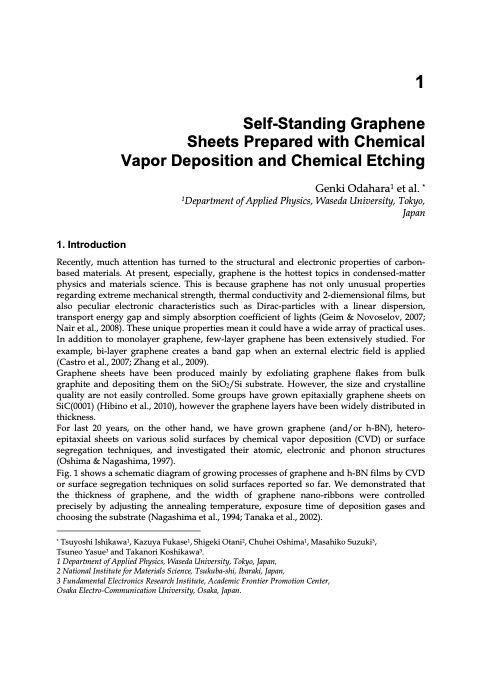PDF Publication Title:
Text from PDF Page: 013
1. Introduction 1 Self-Standing Graphene Sheets Prepared with Chemical Vapor Deposition and Chemical Etching Genki Odahara1 et al. * 1Department of Applied Physics, Waseda University, Tokyo, Japan Recently, much attention has turned to the structural and electronic properties of carbon- based materials. At present, especially, graphene is the hottest topics in condensed-matter physics and materials science. This is because graphene has not only unusual properties regarding extreme mechanical strength, thermal conductivity and 2-diemensional films, but also peculiar electronic characteristics such as Dirac-particles with a linear dispersion, transport energy gap and simply absorption coefficient of lights (Geim & Novoselov, 2007; Nair et al., 2008). These unique properties mean it could have a wide array of practical uses. In addition to monolayer graphene, few-layer graphene has been extensively studied. For example, bi-layer graphene creates a band gap when an external electric field is applied (Castro et al., 2007; Zhang et al., 2009). Graphene sheets have been produced mainly by exfoliating graphene flakes from bulk graphite and depositing them on the SiO2/Si substrate. However, the size and crystalline quality are not easily controlled. Some groups have grown epitaxially graphene sheets on SiC(0001) (Hibino et al., 2010), however the graphene layers have been widely distributed in thickness. For last 20 years, on the other hand, we have grown graphene (and/or h-BN), hetero- epitaxial sheets on various solid surfaces by chemical vapor deposition (CVD) or surface segregation techniques, and investigated their atomic, electronic and phonon structures (Oshima & Nagashima, 1997). Fig. 1 shows a schematic diagram of growing processes of graphene and h-BN films by CVD or surface segregation techniques on solid surfaces reported so far. We demonstrated that the thickness of graphene, and the width of graphene nano-ribbons were controlled precisely by adjusting the annealing temperature, exposure time of deposition gases and choosing the substrate (Nagashima et al., 1994; Tanaka et al., 2002). * Tsuyoshi Ishikawa1, Kazuya Fukase1, Shigeki Otani2, Chuhei Oshima1, Masahiko Suzuki3, Tsuneo Yasue3 and Takanori Koshikawa3. 1 Department of Applied Physics, Waseda University, Tokyo, Japan, 2 National Institute for Materials Science, Tsukuba-shi, Ibaraki, Japan, 3 Fundamental Electronics Research Institute, Academic Frontier Promotion Center, Osaka Electro-Communication University, Osaka, Japan.PDF Image | GRAPHENE SYNTHESIS CHARACTERIZATION PROPERTIES

PDF Search Title:
GRAPHENE SYNTHESIS CHARACTERIZATION PROPERTIESOriginal File Name Searched:
Graphene-Synthesis.pdfDIY PDF Search: Google It | Yahoo | Bing
Salgenx Redox Flow Battery Technology: Power up your energy storage game with Salgenx Salt Water Battery. With its advanced technology, the flow battery provides reliable, scalable, and sustainable energy storage for utility-scale projects. Upgrade to a Salgenx flow battery today and take control of your energy future.
CONTACT TEL: 608-238-6001 Email: greg@infinityturbine.com (Standard Web Page)